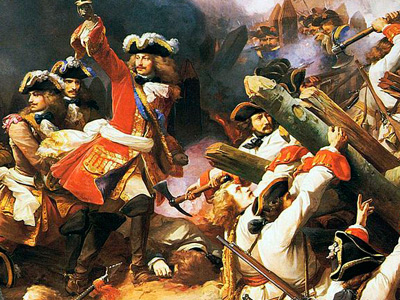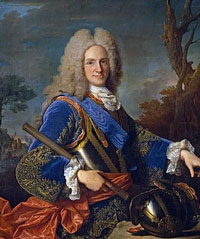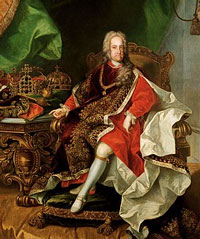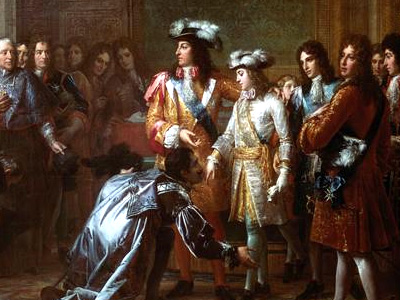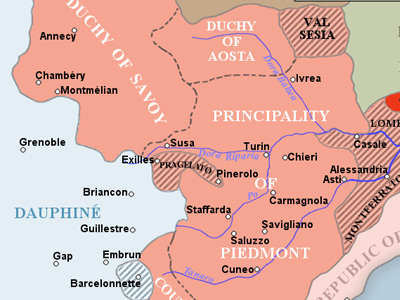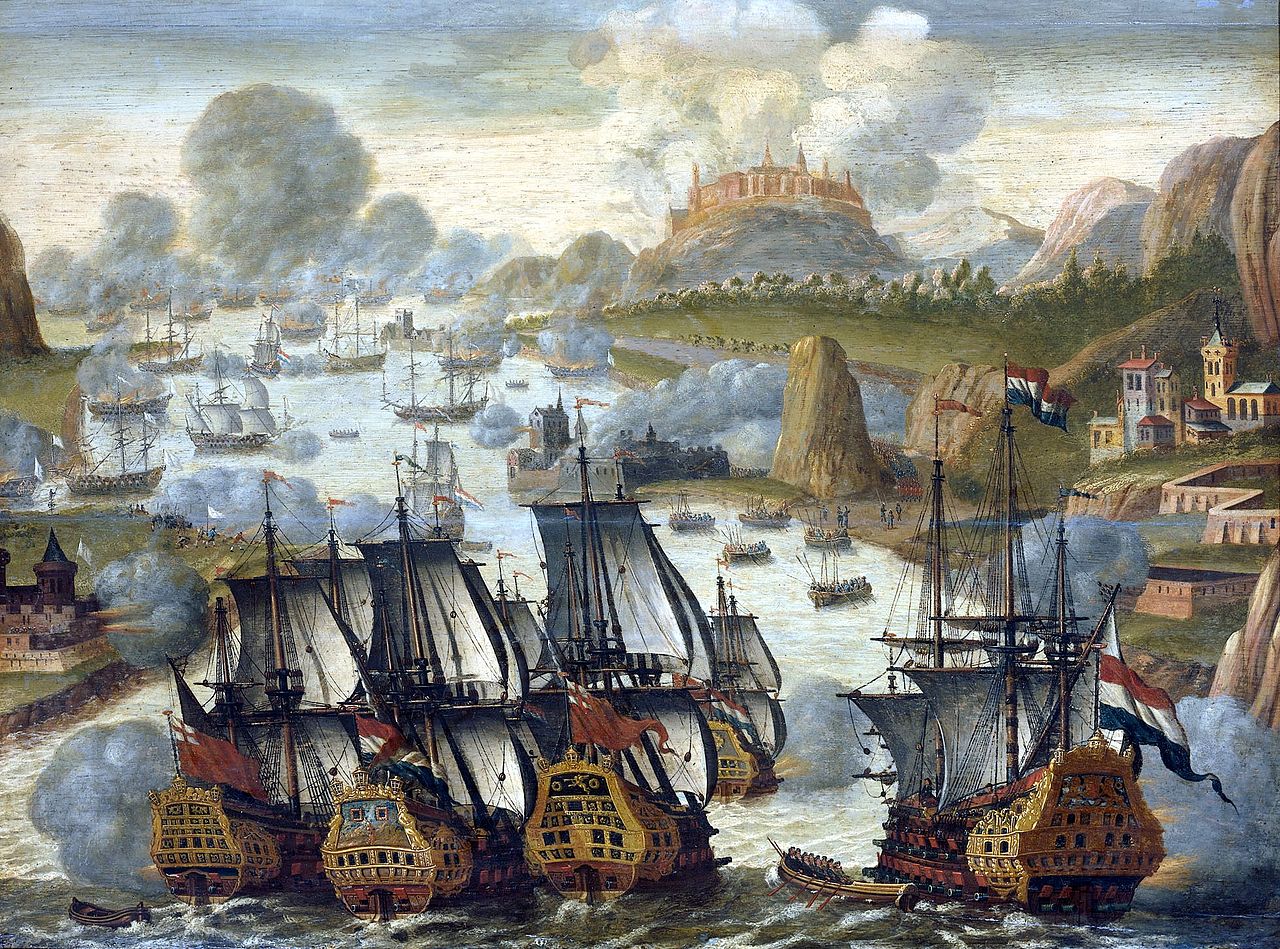War of the Spanish Succession (1702–1715)
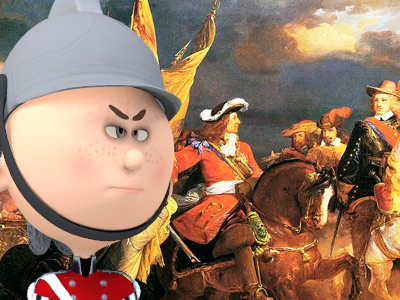
Low Countries, Rhine and Danube
The first aim of the Anglo-Dutch army in the Low Countries was to take possession of the Meuse and Lower Rhine fortresses handed to the Bourbons by Joseph Clemens, and clear the French under Marshal Boufflers from threatening the Dutch border. This was largely achieved by the Allies in 1702, first by taking Kaiserswerth in June, then by prying the French out of several minor fortresses on the Muese: Venlo, Stevensweert, Roermond, and more importantly, Liège, which fell in late October. Marlborough (elevated to a dukedom in December) and the Dutch The Dutch Republic was a confederation that existed from 1579, during the Dutch Revolt, to 1795. It was a predecessor state of the Netherlands and the first fully independent Dutch nation state. Although the state was small and contained only around 1.5 million inhabitants, it controlled a worldwide network of seafaring trade routes. The income from this trade allowed the Dutch Republic to compete militarily against much larger countries. It amassed a huge fleet of 2,000 ships, initially larger than the fleets of England and France combined. generals had removed the immediate French threat, and Joseph Clemens fled to France
The Dutch Republic was a confederation that existed from 1579, during the Dutch Revolt, to 1795. It was a predecessor state of the Netherlands and the first fully independent Dutch nation state. Although the state was small and contained only around 1.5 million inhabitants, it controlled a worldwide network of seafaring trade routes. The income from this trade allowed the Dutch Republic to compete militarily against much larger countries. It amassed a huge fleet of 2,000 ships, initially larger than the fleets of England and France combined. generals had removed the immediate French threat, and Joseph Clemens fled to France The Kingdom of France is the historiographical name or umbrella term given to various political entities of France in the medieval and early modern period. It was one of the most powerful states in Europe since the High Middle Ages. It was also an early colonial power, with possessions around the world. Colonial conflicts with Great Britain led to the loss of much of its North American holdings by 1763. The Kingdom of France adopted a written constitution in 1791, but the Kingdom was abolished a year later and replaced with the First French Republic.. However, in 1703 Allied progress was more mixed. Rheinberg and Bonn, fell at the beginning of the campaign, and Huy, Limbourg and Guelder were taken towards the end. Nevertheless, the 'Great Design' to secure Antwerp and thereby open the river lines into Flanders and Brabant, was left in ruins by Marshal Villeroi's initiative, poor Allied co-ordination, and by General Obdam's defeat at the Battle of Ekeren on 30 June.
The Kingdom of France is the historiographical name or umbrella term given to various political entities of France in the medieval and early modern period. It was one of the most powerful states in Europe since the High Middle Ages. It was also an early colonial power, with possessions around the world. Colonial conflicts with Great Britain led to the loss of much of its North American holdings by 1763. The Kingdom of France adopted a written constitution in 1791, but the Kingdom was abolished a year later and replaced with the First French Republic.. However, in 1703 Allied progress was more mixed. Rheinberg and Bonn, fell at the beginning of the campaign, and Huy, Limbourg and Guelder were taken towards the end. Nevertheless, the 'Great Design' to secure Antwerp and thereby open the river lines into Flanders and Brabant, was left in ruins by Marshal Villeroi's initiative, poor Allied co-ordination, and by General Obdam's defeat at the Battle of Ekeren on 30 June.
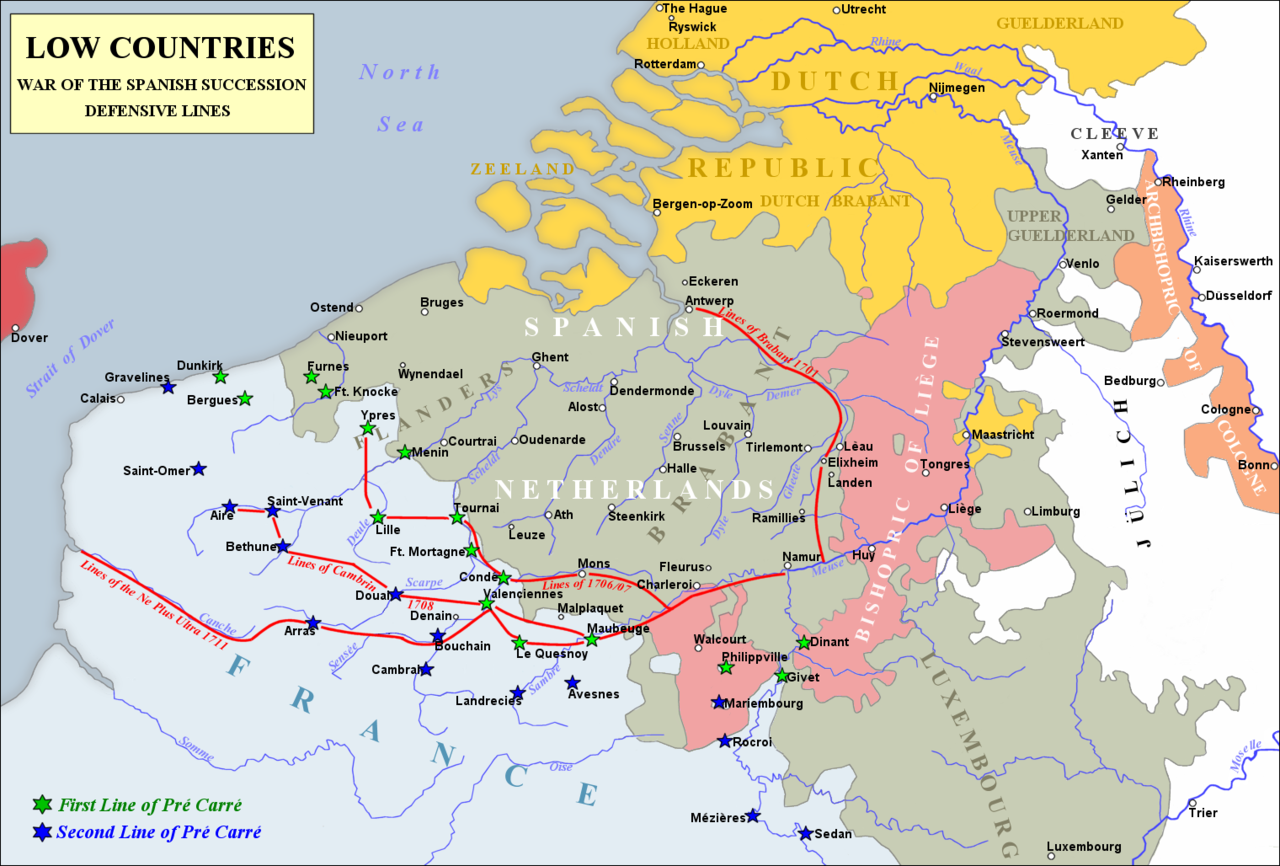
Low Countries. Vauban's so-called pré carré – a double line of French fortresses guarding the frontier – and French defensive lines constructed at various stages of the war

Low Countries. Vauban's so-called pré carré – a double line of French fortresses guarding the frontier – and French defensive lines constructed at various stages of the war
( Click image to enlarge)
Meanwhile, Prince Louis of Baden, the Imperial commander-in-chief, had stood guard on the Upper Rhine, and on 9 September 1702 he captured Landau, the key to Alsace. However, in the opening years of the war it was the French who gained the upper hand in southern Germany. On 14 October Claude de Villars narrowly defeated Baden in the Black Forest at the Battle of Friedlingen, thereby opening up communications between the French on the Rhine and the Bavarians on the Upper Danube. The Elector of Bavaria's support for the Bourbon cause was a grave concern to the Emperor, but for the French it created new opportunities: it undermined the Allied position in southern Germany, and it facilitated a potential strike towards Vienna or across the Alps into northern Italy. By the time Villars arrived on the Danube in May 1703, the Elector had taken several strong-points along the river, from Ulm to Regensburg. Although the Elector's campaign in the Tyrol was defeated by the sharpshooting mountain men in June–August, on the Danube he remained dominant, and on 20 September he and Villars defeated an Imperial detachment at the Battle of Höchstädt. The victory could not save the increasingly hostile relationship between the two generals, and Marshal Marsin replaced Villars in theatre. Nevertheless, the French maintained their momentum, not only on the Danube, but also back on the Rhine where Marshal Tallard took Breisach in September, defeated the Landgrave of Hesse-Kassel at the Battle of Speyerbach on 15 November, then recaptured Landau.

Holy Roman Empire. Beyond the Low Countries the main action occurred along Moselle, the Rhine, and the Upper Danube

Holy Roman Empire. Beyond the Low Countries the main action occurred along Moselle, the Rhine, and the Upper Danube
( Click image to enlarge)
In December 1703 the Elector of Bavaria seized Augsburg; in mid-January 1704 he took Passau on the Danube, adding further pressure on Leopold I in Vienna. The threat to the Emperor was exacerbated by Francis II Rákóczi's anti-Habsburg revolt in Hungary where, due to the devastation of the recent war with the Ottoman Empire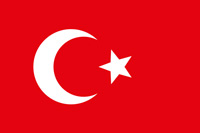 The Ottoman Empire, also known as the Turkish Empire, was an empire that controlled much of Southeast Europe, Western Asia, and Northern Africa between the 14th and early 20th centuries. The Ottomans ended the Byzantine Empire with the conquest of Constantinople in 1453. The Ottoman Empire's defeat and the occupation of part of its territory by the Allied Powers in the aftermath of World War I resulted in its partitioning and the loss of its Middle Eastern territories. and the subsequent imposition of high taxes and feudal burdens, the people had risen up to restore the old constitution. With Hungarian rebels approaching Vienna from the east and the French and Bavarians threatening from west, it was essential for the Allies to resolve the problem posed by Bavaria. To this end, Marlborough marched up the Rhine from the Low Countries in May; in June he united his forces with Baden north of the Danube, before securing a crossing on the river at Donauwörth on 2 July. Bavaria now lay open to attack, but Max Emanuel, knowing Tallard was bringing reinforcements from the Rhine, could be persuaded by neither pressure nor inducements to abandon his French alliance.
The Ottoman Empire, also known as the Turkish Empire, was an empire that controlled much of Southeast Europe, Western Asia, and Northern Africa between the 14th and early 20th centuries. The Ottomans ended the Byzantine Empire with the conquest of Constantinople in 1453. The Ottoman Empire's defeat and the occupation of part of its territory by the Allied Powers in the aftermath of World War I resulted in its partitioning and the loss of its Middle Eastern territories. and the subsequent imposition of high taxes and feudal burdens, the people had risen up to restore the old constitution. With Hungarian rebels approaching Vienna from the east and the French and Bavarians threatening from west, it was essential for the Allies to resolve the problem posed by Bavaria. To this end, Marlborough marched up the Rhine from the Low Countries in May; in June he united his forces with Baden north of the Danube, before securing a crossing on the river at Donauwörth on 2 July. Bavaria now lay open to attack, but Max Emanuel, knowing Tallard was bringing reinforcements from the Rhine, could be persuaded by neither pressure nor inducements to abandon his French alliance.
On 13 August, therefore, Marlborough, now joined by Prince Eugene and commanding in total some 52,000 men, attacked the slightly larger Franco-Bavarian army on the Danube near Höchstädt an der Donau. What came to be known in England as the Battle of Blenheim, proved a decisive defeat for Bavaria. Tallard was taken prisoner while Marsin escaped back across the Rhine. Ulm and Ingolstadt soon fell, followed by Trier, Landau, and in December, Trarbach, in preparation for an Allied attack up the Moselle the following year. Max Emanuel returned to govern the Spanish Netherlands, and by the terms of the Treaty of Ilbersheim (7 November) his Bavarian lands were placed under Austrian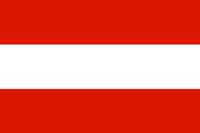 The Archduchy of Austria was a major principality of the Holy Roman Empire and the nucleus of the Habsburg monarchy. With its capital at Vienna, the archduchy was centered at the Empire's southeastern periphery. The archduchy's history as an imperial state ended with the dissolution of the Holy Roman Empire in 1806. It was replaced with the Lower and Upper Austria crown lands of the Austrian Empire. rule. The threat to knock the Emperor out of the war had been averted.
The Archduchy of Austria was a major principality of the Holy Roman Empire and the nucleus of the Habsburg monarchy. With its capital at Vienna, the archduchy was centered at the Empire's southeastern periphery. The archduchy's history as an imperial state ended with the dissolution of the Holy Roman Empire in 1806. It was replaced with the Lower and Upper Austria crown lands of the Austrian Empire. rule. The threat to knock the Emperor out of the war had been averted.
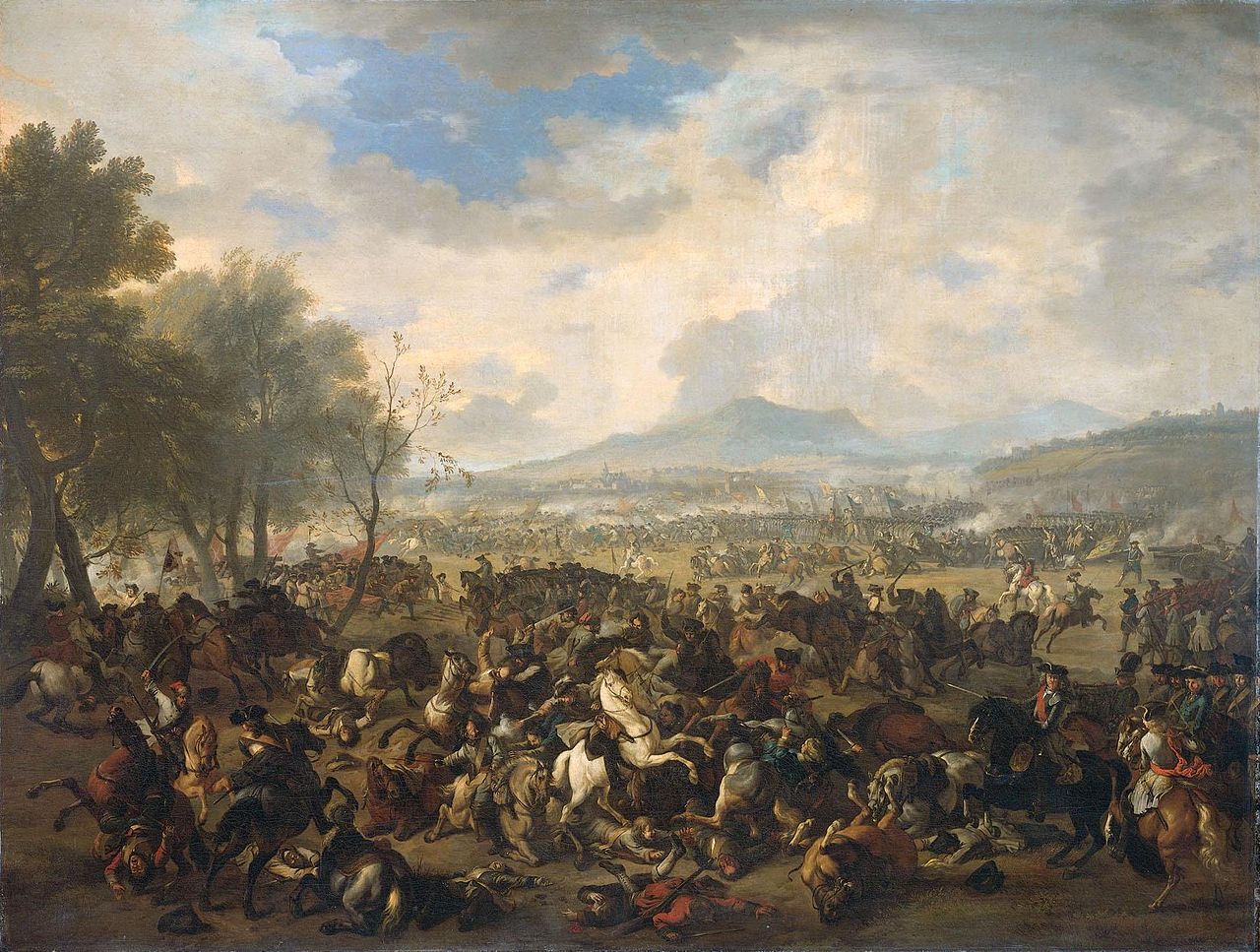
The Battle of Ramillies between the French and the English, 23 May 1706

The Battle of Ramillies between the French and the English, 23 May 1706
( Click image to enlarge)
The Blenheim campaign dominated the war in 1704. For Louis XIV, the defeat was a severe blow to his prestige, but there were some consolations that year, including Marshals Montrevel's and Villars' success against the Allied-backed Camisard revolt in the Cévennes (although a low-level guerilla war dragged on for several additional years). For Marlborough, the Blenheim campaign secured his reputation and was seen by many as a vindication of the continental strategy, but for England The Kingdom of England was a sovereign state on the island of Great Britain from about 927, when it emerged from various Anglo-Saxon kingdoms, until 1 May 1707, when it united with Scotland to form the Kingdom of Great Britain. The Viking invasions of the 9th century upset the balance of power between the English kingdoms, and native Anglo-Saxon life in general. The English lands were unified in the 10th century in a reconquest completed by King Æthelstan in 927. the pressing need now was for the Emperor to make peace in Hungary, and for the Allies to resume the attack against France on all fronts. However, Marlborough's attempt in 1705 to by-pass the Low Countries and invade Louis XIV's kingdom via the Moselle, proved a failure. With Villars entrenched at Sierck, and with the German princes failing to fully support the attack, the Duke was forced to return to the Meuse in mid-June. Little was achieved here, though, beyond forestalling a French offensive and forcing the Lines of Brabant at Elixheim, south of Zoutleeuw (Léau), on 17/18 July.
The Kingdom of England was a sovereign state on the island of Great Britain from about 927, when it emerged from various Anglo-Saxon kingdoms, until 1 May 1707, when it united with Scotland to form the Kingdom of Great Britain. The Viking invasions of the 9th century upset the balance of power between the English kingdoms, and native Anglo-Saxon life in general. The English lands were unified in the 10th century in a reconquest completed by King Æthelstan in 927. the pressing need now was for the Emperor to make peace in Hungary, and for the Allies to resume the attack against France on all fronts. However, Marlborough's attempt in 1705 to by-pass the Low Countries and invade Louis XIV's kingdom via the Moselle, proved a failure. With Villars entrenched at Sierck, and with the German princes failing to fully support the attack, the Duke was forced to return to the Meuse in mid-June. Little was achieved here, though, beyond forestalling a French offensive and forcing the Lines of Brabant at Elixheim, south of Zoutleeuw (Léau), on 17/18 July.
Poor Allied co-operation, tactical disputes and command rivalries, ensured the Allies made little progress in 1705 on either the Meuse or the Moselle; there was also a setback in occupied Bavaria where the Emperor's heavy taxation and forced recruitment led to a brief peasant revolt. Nevertheless, in 1706 the Allies would at last make the breakthrough in the Low Countries when, on 23 May, Marlborough defeated Villeroi and the Elector of Bavaria at the Battle of Ramillies north of Namur. Each side fielded some 60,000 men, but it was the English general, taking advantage of his opponent’s weak disposition, who won a decisive victory. A two-week pursuit of their shattered opponents quickly secured a number of ill-defended towns, including Brussels, Ghent, Bruges, and Antwerp; a second campaigning phase required the application of more substantial siegeworks, but the Allies eventually captured Ostend, Menen (thereby breaching the first line of Vauban's pré carré), Dendermonde, and Ath. The Spanish Netherlands was re-established as the buffer zone between France and the Dutch Republic, and the territory became an Anglo-Dutch condominium for the duration of the war, governed in the name of Charles III but in accordance with the directives from the Maritime Powers. For their part, the Franco-Bavarian army fell back to a new defensive line running between Ypres and Namur, via Lille, Tournai, Condé, Mons, and Charleroi.
Due to the defeat at Ramillies, Villars on the Rhine had been ordered to send troops north to Flanders to bolster French fortunes, thereby curtailing his own campaign in 1706. However, in 1707 Villars would at last make a significant breakthrough when, following Baden's death in January, he pushed back the new Imperial commander-in-chief, the Margrave of Bayreuth, and forced the Lines of Stollhofen without loss in May, thus enabling him to harvest vital resources in Baden and Württemberg. This victory was mirrored on other fronts that year, including in Spain The Spanish Empire was a colonial empire governed by Spain and its predecessor states between 1492 and 1976. One of the largest empires in history, it was the first to usher the European Age of Discovery and achieve a global scale, controlling vast territory. It was one of the most powerful empires of the early modern period, reaching its maximum extent in the 18th century. and south-eastern France. In the Spanish Netherlands, moreover, the Bourbons had some success when the Elector of Bavaria and Marshal Vendôme (Villeroi's replacement) parried all Marlborough's thrusts – a setback which Anne's Captain-General blamed partly on the fact that his field army had to cover the newly-held towns of Brabant.
The Spanish Empire was a colonial empire governed by Spain and its predecessor states between 1492 and 1976. One of the largest empires in history, it was the first to usher the European Age of Discovery and achieve a global scale, controlling vast territory. It was one of the most powerful empires of the early modern period, reaching its maximum extent in the 18th century. and south-eastern France. In the Spanish Netherlands, moreover, the Bourbons had some success when the Elector of Bavaria and Marshal Vendôme (Villeroi's replacement) parried all Marlborough's thrusts – a setback which Anne's Captain-General blamed partly on the fact that his field army had to cover the newly-held towns of Brabant.
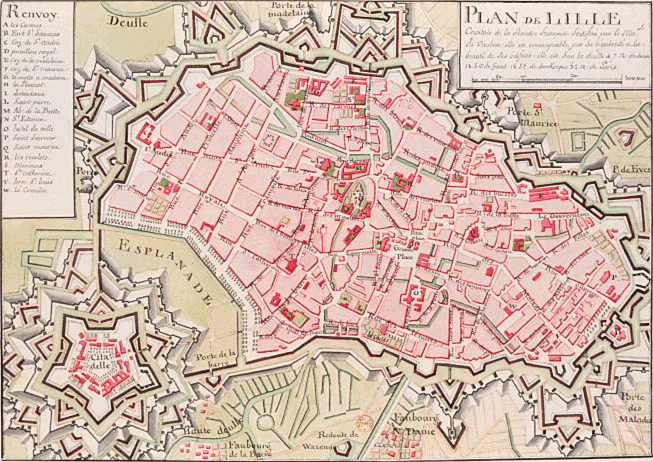
Vauban's masterpiece, Lille, and its five bastioned citadel to the west
In 1708 the Duke of Berwick moved from Spain to the Rhine to campaign with the Elector of Bavaria. The fighting in Germany proved sterile, however, and the two generals would end up supporting the main French effort in Flanders where Vendôme, under the nominal command of the Duke of Burgundy, planned to take the offensive. To create a diversion Louis XIV supported James Edward Stuart's descent on Scotland, a country where dissatisfaction over the recent political union with England made it ripe for rebellion. However, due poor navigation and indecision, the attempt in March proved a fiasco, and Claude de Forbin's invasion fleet returned to Dunkirk. Despite this setback, the campaign in Flanders began well for Louis XIV's generals. Taking advantage of popular discontent with the new Allied administration, Ghent and Bruges defected to the Bourbons in early July, thereby returning much of Spanish Flanders to French control. Marlborough had been caught off-balance, but it was now he, encouraged and assisted by Eugene newly arrived from the Moselle, who took the decisive action. After a forced march the Allied army, comprising some 80,000 men, engaged Vendôme's and Burgundy's slightly larger force on the river Scheldt and won another major victory at the Battle of Oudenarde on 11 July 1708. The success, aided by the dissension of the two French commanders, was followed by the Siege of Lille in August. Vendôme, Burgundy, and Berwick combined their forces to form a numerically superior field army, but they failed to attack Marlborough's covering force; attempts to disrupt supply routes were also thwarted, notably by Webb at the Battle of Wijnendale on 28 September. Consequently, Boufflers was compelled to surrender the town of Lille on 22 October, and eventually its citadel on 9 December. The siege had been costly for the Allies: it had tied down their army for several months, and it had been an orthodox sequel to the victory at Oudenarde. However, Marlborough and Eugene had recovered control of the Spanish Netherlands and had widened the breach of the first line of the pré carré, exposing northern France to attack. Ghent was retaken at the end of December and Bruges capitulated shortly after, thereby restoring the authority of the Anglo-Dutch condominium.
HISTORY
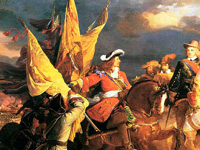
RESOURCES
This article uses material from the Wikipedia article "War of the Spanish Succession", which is released under the Creative Commons Attribution-Share-Alike License 3.0.
© Stories Preschool. All Rights Reserved.
